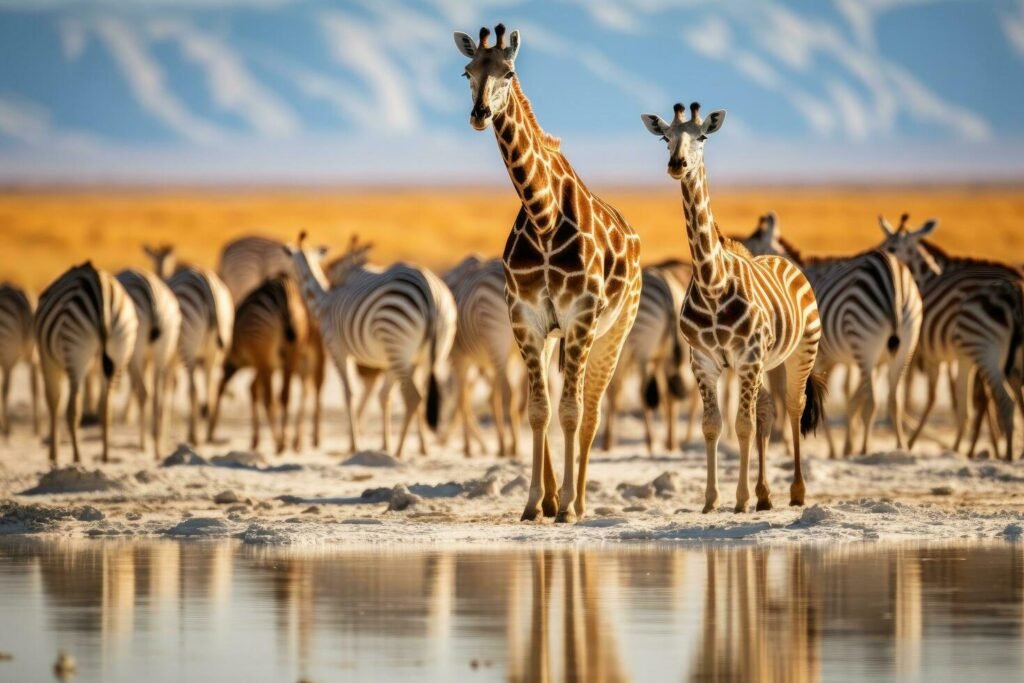Etosha National Park is one of Namibia’s most iconic wildlife destinations and a premier African safari location. Known for its vast salt pans, abundant wildlife, and striking landscapes, Etosha is one of the largest national parks in Africa. The park offers a unique safari experience, as it features an expansive, open landscape that makes wildlife viewing easier, especially around waterholes. It is a must-visit for nature lovers and those interested in experiencing Namibia’s diverse ecosystems.

1. Location and Geography
- Location: Etosha National Park is situated in the northwestern part of Namibia, covering a vast area of 22,270 square kilometers (8,600 square miles). The park is located in the Kunene Region, and it is easily accessible from major cities such as Windhoek (Namibia’s capital), Ongwediva, and Oshakati.
- Geography: The park is dominated by the massive Etosha Pan, a large salt pan that spans around 5,000 square kilometers. This pan is a remnant of an ancient lake that once covered much of the area. The pan is dry for most of the year, but during the rainy season, it can transform into a seasonal wetland. The park is also characterized by woodlands, savannas, and grasslands, with several waterholes scattered across its expansive landscape. These waterholes are critical for wildlife, particularly during the dry season.
- Climate: Etosha has a semi-arid climate, with hot, dry conditions in the summer (October to April) and cooler temperatures in the winter (May to September). The park experiences most of its rainfall during the wet season, with occasional thunderstorms, but the area is largely arid, especially in the southern and central parts.
2. Wildlife and Biodiversity
Etosha National Park is home to a remarkable variety of animals, with an emphasis on both the Big Five and the park’s diverse birdlife. The dry landscape and concentration of wildlife around waterholes make the park an excellent destination for game viewing.
- Big Five:
- Lions: Etosha’s lions are a major attraction. They are often seen at waterholes, where they gather to drink, or in the more bushy areas. The park has a substantial lion population, and sightings are frequent.
- Elephants: Etosha is home to a large population of African elephants, particularly in the central and western regions. These elephants are known for their remarkable ability to survive in the park’s harsh conditions, and sightings are common.
- Rhinos: Etosha is one of the best places in Africa to see both black rhinos and white rhinos. The park is particularly known for its efforts in rhino conservation, and its population of black rhinos is one of the largest in the world.
- Buffaloes: Large herds of African buffaloes can often be seen at Etosha’s waterholes, especially during the dry season when animals congregate around these vital sources of water.
- Leopards: Though leopards are elusive, they do inhabit Etosha’s landscapes, especially in the more remote and forested areas of the park.
- Other Mammals: In addition to the Big Five, Etosha is home to a wide variety of other mammals, including giraffes, zebras, wildebeests, impalas, oryx, springboks, kudu, and hyenas. The park is also one of the best places in Southern Africa to spot cheetahs, as they roam the open savannas in search of prey.
- Birdlife: With over 340 species of birds recorded, Etosha is a paradise for bird watchers. The park hosts a wide variety of bird species, especially around its waterholes and the Etosha Pan. Notable species include greater flamingos, lesser flamingos, African fish eagles, white-backed vultures, hornbills, and sandgrouse. During the wet season, migratory birds flock to the park, making it even more attractive for birding.
- Reptiles: Etosha also has a variety of reptiles, including Nile crocodiles in its permanent waterholes and several species of snakes, lizards, and turtles that thrive in the park’s arid conditions.
3. Safari Activities
Etosha National Park offers a range of safari activities, allowing visitors to explore the park’s diverse ecosystems and witness its extraordinary wildlife.
- Self-Drive Safaris: Etosha is one of the best parks in Africa for self-drive safaris due to its excellent road network, which is clearly marked and well-maintained. Visitors can rent a vehicle and explore the park at their own pace, with multiple routes that pass by various waterholes and viewpoints.
- The central and western parts of the park are the most popular for self-drive, with the Okaukuejo, Halali, and Namutoni camps offering easy access to waterholes where animals frequently congregate.
- Guided Game Drives: For a more immersive experience, visitors can join guided game drives with expert rangers who provide in-depth knowledge of the park’s wildlife, ecosystems, and conservation efforts. These drives are offered at various times of the day, including early morning and late afternoon, when wildlife is most active.
- Night Drives: Some of the park’s camps, such as Okaukuejo, offer night drives, where visitors can spot nocturnal animals like leopards, hyenas, and brown hyenas, as well as smaller creatures that are typically not visible during the day.
- Walking Safaris: Etosha also offers walking safaris in select areas, providing a more intimate way to explore the park’s wildlife and learn about the smaller animals, insects, and plants that make up the park’s ecosystem.
- Bird Watching: Bird watching is a significant activity in Etosha, especially during the wet season when migratory birds arrive. The park’s diverse habitats, such as the Etosha Pan and its surrounding wetlands, attract a wide variety of bird species. Bird watchers can spot flamingos, eagles, and herons, among other species.
4. Best Time to Visit Etosha National Park
The best time to visit Etosha depends on your safari preferences, particularly related to wildlife viewing and weather conditions.
- Dry Season (May to October): The dry season is the most popular time to visit Etosha, especially for game viewing. During this period, the park’s waterholes become the primary source of water for animals, so they congregate around these waterholes, making it easier to spot wildlife. The heat of the day drives many animals to drink, creating excellent photographic opportunities. The dry season also offers cooler temperatures and lower humidity, making it more comfortable for safari activities.
- Wet Season (November to April): While the wet season is less ideal for game viewing due to the lush vegetation and scattered water sources, it’s still a beautiful time to visit. The park becomes lush and green, and many animals give birth during this period. Additionally, the wet season is prime for bird watching as migratory species arrive in the park. The wet season also offers fewer tourists, providing a more tranquil safari experience.
5. Accommodation in Etosha National Park
Etosha National Park offers a range of accommodations to suit different budgets and preferences, from basic campsites to luxury lodges. The main accommodation options are spread across several camps within and around the park.
- Okaukuejo Camp: Okaukuejo is the main camp in the park and offers a range of accommodation options, from chalets to campsites. It’s known for its famous waterhole, where visitors can observe wildlife, including elephants and lions, day and night.
- Halali Camp: Located in the central part of the park, Halali offers comfortable chalets and a cozy atmosphere. It is strategically located near several waterholes and is ideal for both self-drive and guided safari enthusiasts.
- Namutoni Camp: Situated in the eastern part of Etosha, Namutoni is a historic fort converted into a safari lodge. It offers a mix of accommodation options, including rooms and camping facilities, and provides access to some of the park’s best game-viewing areas.
- Private Lodges: In addition to the park’s rest camps, there are several luxury lodges on the outskirts of the park. These include options like Mokuti Etosha Lodge, which is located near the park’s eastern entrance, offering high-end accommodations with guided safaris.
- Camping: For those seeking a more rustic experience, Etosha offers campsites in each of its main camps, allowing visitors to enjoy the natural surroundings of the park under the stars.
